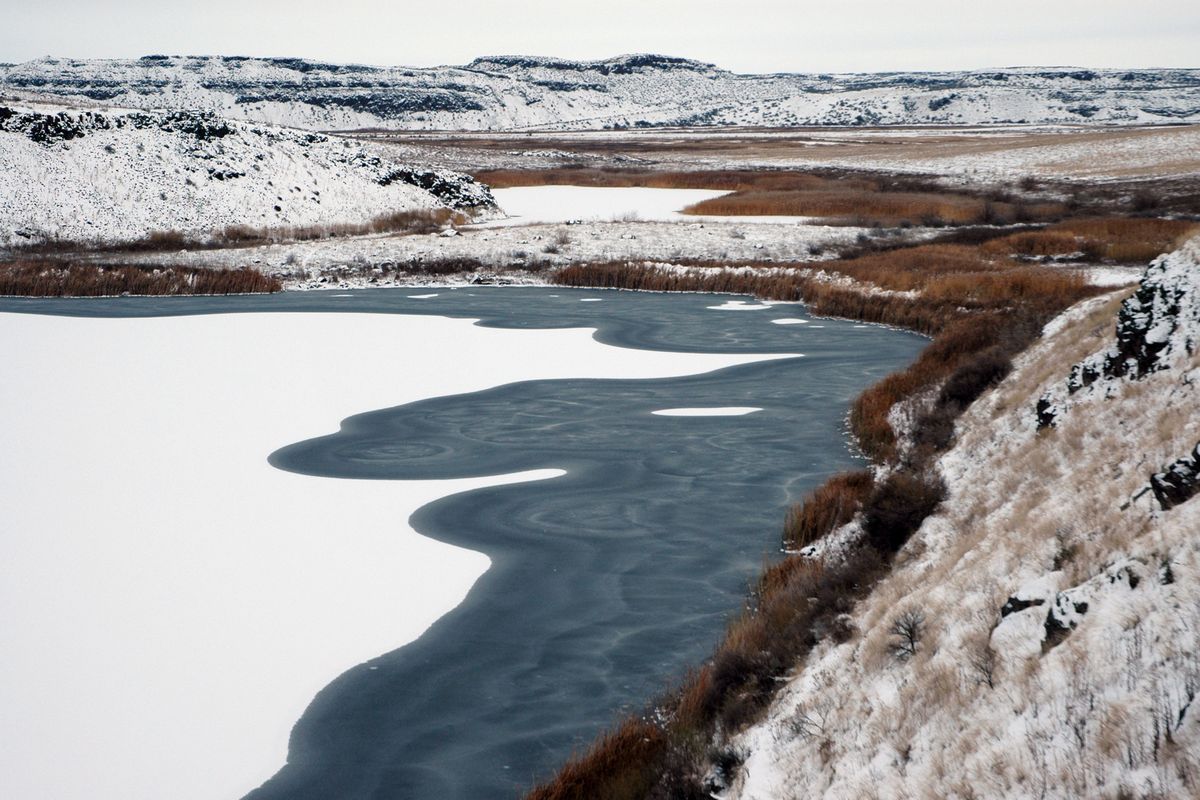Fresh snow turns sagebrush steppe into garden of life

Snow dapples the cattails. Ice forms symmetrical patterns on a lake. Animal tracks meander through the sagebrush, leaving mysteries in their wake.
Winter is a fascinating time to wander in the near-desert zone astride the Columbia River in south-central Washington’s sagebrush steppe, where wildlife reserves blend with fruit orchards and vineyards.
Heavy snow is rare here, but a light dusting is priceless.
Fresh snow turns the parched desert landscape, a wasteland to many pass-through visitors, into a garden of life.
A two-hour drive from Spokane puts you in the heart of the area near Othello.
This is a low desert, below 1,000 feet in elevation, and distinctly different than Oregon’s high desert, much of it above 4,000 feet.
The lower altitude, with coulees carved into a rolling plateau by Ice Age Floods, gives the Columbia Basin some winter visit advantages over high-altitude snow zones:
• You don’t need to drive over a mountain pass to get there.
• You don’t need snowshoes or skis because boots are enough for traipsing in the snow.
• And you won’t be fighting crowds. Winter adventurers who find their way to Hanford Reach National Monument and the Columbia National Wildlife Refuge will share the desert with only a few late-season hunters.
Having some locals there is a good thing because it injects a bit of confidence in driving over snow-covered roads.
We began the tour at Desert Aire, on the Columbia River 20 miles south of Vantage and Interstate 90. Desert Aire gets only 7.5 inches of moisture annually and 100-degree heat is common in summer. Puget Sounders come here to dry out their rheumatoid arthritis.
Wahluke wine country
The community of 1,200 has a park on the river, a golf course and, most important for winter visitors, the only motel for miles around.
The nearby town of Mattawa, population 3,000, is the area’s hub, with a half-dozen Latino grocery stores serving families of workers who tend the many orchards and vineyards.
This is Washington’s Wahluke slope, where 20 percent of the wine grapes are grown in a state second only to California in production.
Priest Rapids Wildlife Area
We pushed past 6-foot-high dried cattails, reeds and grasses at the edge of the frozen marsh to reach a sandy beach in a backchannel of the Columbia River.
We tossed rocks onto the ice, seeing whether they would break through, but they only made a dull thunk before sliding to a stop.
Snow-shrouded cliffs of Sentinel Gap, an 1,800-foot cut made by the river in Saddle Mountain, loomed in the distance. The slow current in Priest Rapids Reservoir kept the open water free from ice.
Robins chirped from bare trees and northern flickers showed orange wings against the steel gray sky. Animal tracks were scattered here and there in powdery snow.
Hanford Reach Monument
Protected as a U.S. Fish and Wildlife Service national monument, this is the country’s only free-flowing part of the Columbia above tidewater.
While eating lunch in the pickup, we watched hundreds of water birds – white pelicans, cormorants, mallards, buffleheads and other ducks – ride the river’s current. They all seemed to stop at a predetermined place, just before passing one of Hanford’s cocooned nuclear reactors on the far shore, then flew back upstream to ride the river.
We bookended lunch with two short hikes: one where the old ferry crossed the river near the 300-foot-high White Bluffs, the other from the road’s end with its Columbia River vista.
Surprising a mule deer, we watched it bound through sagebrush to the sandstone pinnacle where we were headed. It took the deer two minutes to get there; we needed 25.
Despite the thrill of watching the deer run, we regretted having startled it. What if it didn’t survive winter because of added stress? The encounter made us resolve to watch wildlife from a distance, through binoculars.
Columbia Wildlife Refuge
After driving to a motel in Othello, a prosperous agriculture-processing town of 6,000, we drove the next day 15 minutes north to the Columbia National Wildlife Refuge.
The refuge is adjacent to several state wildlife areas and vast Potholes Reservoir, an ecosystem considered by many to be Washington’s desert gem. It didn’t disappoint.
Three inches of light snow had fallen overnight, so every track we made was fresh – unless an animal got there before us.
We stopped for hikes at Frog and Goose lakes, but didn’t walk far. In winter, the enjoyment comes from being there – from standing in the snow, watching new flakes fall, seeing one’s breath hit the frosty air – more so than in summer, when a hike often has to reach the top of the peak or complete a loop to be considered a success.
After a midday break at Potholes State Park, we parked at ice-free Blythe Lake for a 1-hour walk through snow to Chukar Lake.
Tucked inside a coulee’s low walls, shallow Chukar Lake’s frozen surface mixed an oblong oval of white snow on its central ice with dark ice along shore.